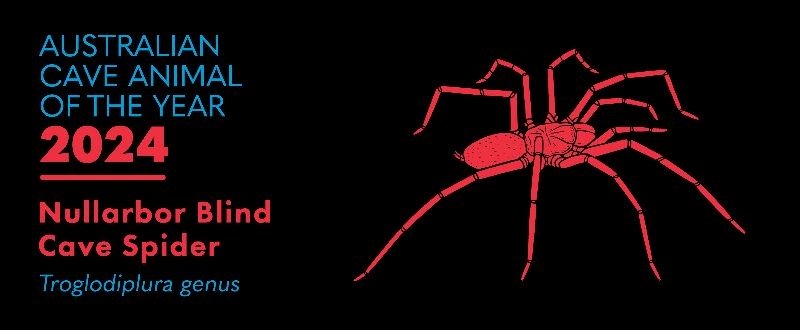Latest Programs
Conservation
Home » Conservation » Latest Programs

Australian Cave Animal of the Year
Cave Animal of the Year was launched in January 2019 and aims to raise the profile of cave animals in the community and draw attention to the importance of caves as important animal habitat. The inaugural Australian Cave Animal of the year is the Tasmanian cave spider Hickmania troglodytes.
The program is inspired by the German Cave Animal of the Year program, which was launched in 2008 and is now in its 12th year.
There is no popular competition to select the ‘winner’. The Tasmanian cave spider was selected as our debut cave animal to coincide with the international success of the film Sixteen Legs. The intention is to have a range of cave animals from around Australia and the selected animal will be a ‘flagship’ for other cave animals.
The 2024 Australian Cave Animal of the year: The little-known genus Troglodiplura, the Nullarbor Blind Cave Spider .

image source: https://www.caveanimaloftheyear.org.au/.
Some beautiful Cave Animal of the Year promotional products have been produced:
- Bookmarks and stickers are readily available.
- The A3 size posters are available for areas where they will be seen by good numbers of people. Classrooms, libraries, outdoor shops, Scout and Guide halls would all be excellent venues.
- Cups. Great for yourself or a gift for your caving friends.
You can help raise the profile of Cave Animals by helping distribute our wares. Please contact: hello@caveanimaloftheyear.org.au
We have a facebook page and a website: www.caveanimaloftheyear.org.au
Thanks to the Karst Conservation Fund for financial support, to the German Speleological Federation for their inspiration, to the International Union of Speleology for funding the stickers and to Poco People and Aeski in Hobart for their exciting art and design work.
Active Programs
Nullarbor Campaign
This campaign is to Stop the Industrialisation of the Nullarbor Plain.
Download the Fundraiser Flyer with details on how to help fund the campaign (tax deductable)
The Campaign PDF Brochure will print as 4 A4 back-to-back pages, but to print as 4 A5 pages use the booklet function in the pdf print menu.
Bushfire Landscape Appeal (from 2020 onwards).
Funds for this were obtained through a Go Fund Me Appeal which raised some $11,000 from donors in Australia and the USA.
Projects initiated were by various ASF Member Clubs and some awarded remain on hold due to Management Agencies denying access due to road closures. This was true of the Bendethera Assessment by ISS and also two Jenolan projects by SUSS (Cave effects and Diving Cave assessments).
Highland Caving Group had found a new way into West Deep Creek Cave which bypassed the inflow in the doline. This was a major discovery which had eluded cavers since the 1950s. Their assessment of bushfire effects allowed them to continue their study of this new extensive cave system (Caves Australia #220 p 16-23 June 2022)
Kangaroo Island was devastated by bushfire. The SA Speleological Council was supported to document and retrieve and investigate caves and karst particularly around Kelly Hill Caves. The results were so successful for the Funds about $10,000 input that the State Government awarded $80,000 to continue the cave documentation work.
Habitat Use and Nightly Foraging Activity of Southern Bent-wing Bats (SBWB) Amanda Bush PhD project.
The support has been in the form of providing miniaturised GPS and radio units which are attached to the bats allowing monitoring of the bat movements. These units need retrieving to download data. The bats are critically endangered. The project is identifying where the bats are obtaining their flying insect food which is mainly moths.
The expenses for the GPS+Radio units were some $11,000 to $12,000. Funding is complete but the research is ongoing.
Thampanna Cave, Mundrabilla Station WA, Track marking and mapping
This project was initiated by Alan and Megan Pryke and involved cavers from numerous ASF clubs. It was initiated before Covid-19 and was thus interrupted for several years. The track marking was to protect delicate areas of “coffee and cream”, halite speleothems and other vulnerable areas. Such delicate areas have been damaged in Mullamullang Cave. A published report: Pryke, M. Thampanna Unveiled Caves Australia 225 August 2023.
Expenses for this project only covered camping fees and track marking and mapping materials, total costs $1,152.
Mt Etna Ghost Bat Genetics Research on the Mt Etna ghost population is nearly complete. This has revealed the 2012-3 population was about 30 individual bats, which was substantiated by models based on the restricted genetic base revealed from the laboratory genetic studies. The Mt Etna population does not interbreed with other populations of the ghost bat in Queensland. This low population is unsustainable. The population has seriously declined in numbers since quarrying destroyed a cave used for over-wintering. Various strategies are being considered to ensure the population’s survival.
Scrubby Creek Cave Property Acquisition, at Murrindal, Victoria. The Fund supported the acquisition of this property by Rimstone Cooperative Ltd. Targeted donations amounted to over $90,000. This project is coming to its conclusion at present with residual funds to be used to quit personal loans for the purchase, to protect the tufa terraces where Scrubby Creek emerges from the cave and to prepare a Management Plan for the continued protection of the cave and the property.
Wombeyan (Melocco) Quarry Project. This project is preparing 3D maps of the Melocco quarry for use preparing educational materials for this historic industrial site.
Systematics and taxonomy of Australian cave crickets (Rhaphidophoridae, Macropathinae), an enigmatic and at-risk fauna. Dr Perry Beasley-Hall
The Australian cave cricket systematics needs review with modern genetic methodolology as the original descriptions based on morphology and biometry needs reviewing. Cave crickets live near the entrances of most caves in Southern Australia and Tasmania. This project current for next three years. Dr Perry Beasley-Hall is at Adelaide University and the SA Museum.
Vulnerability of Australian bats to white-nose syndrome (WNS)
This is studying the over-wintering and hibernation biology of the Eastern Bent-wing Bat in South-Eastern Australia to estimate the vulnerability of cave dwelling bats to the White Nose syndrome fungus (Pseudogymnoascus destructans). ASF support is as partner in a Linkage Project with University of Western Sydney and others. Dr Chris Turbill is heading the project. ASF support is financial and assistance with cave information, maps and access support.
Cave dwelling bats in SE Australia are considered at risk of WNS should the fungus enter Australia and infect cave dwelling bats in the colder areas of their distributions.
Project to continue for next three years.
Ghost Bat (Macroderma gigas): “The Macroderma Initiative: conserving ghost bats and informing development”.
This is a Linkage Project coordinated by Dr Nicola Hanrahan out of Charles Darwin University and approved November 2023 for three years. It has various partners including industry and the Australian Speleological Federation and the Australasian Bat Society.
The ghost bat has been under pressure from quarrying (Mt Etna); has disappeared from The Centre and mining is proposed in the vicinity of the largest colony in the abandoned Pine Creek, NT mine workings.
The ghost bat is known from the Pilbara, the Kimberley, and the sandstone of Arnhem land. Pungalina, NT and Chillagoe, Qld. It is revered by indigenous groups. There were fossil cave sites in the lower SW Western Australian and in the Northern Flinders Range.
Updated 6/4/2024
